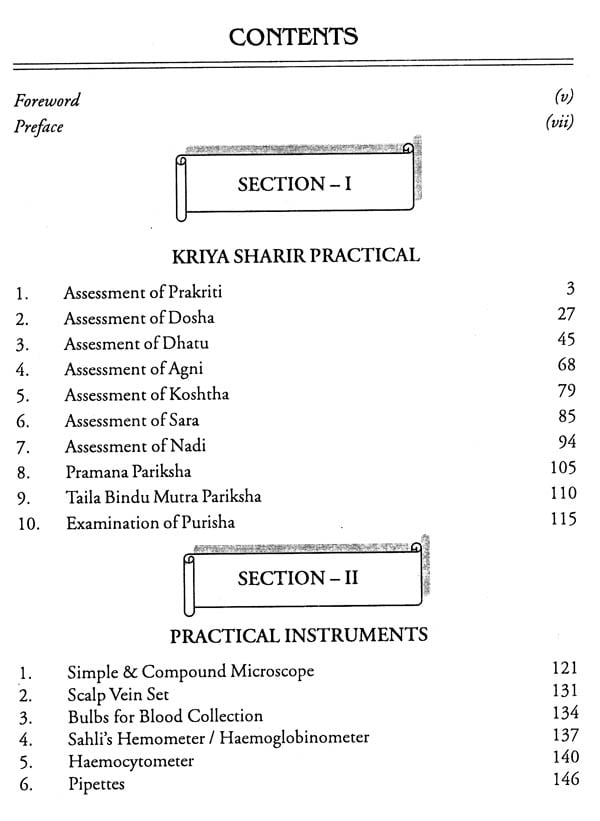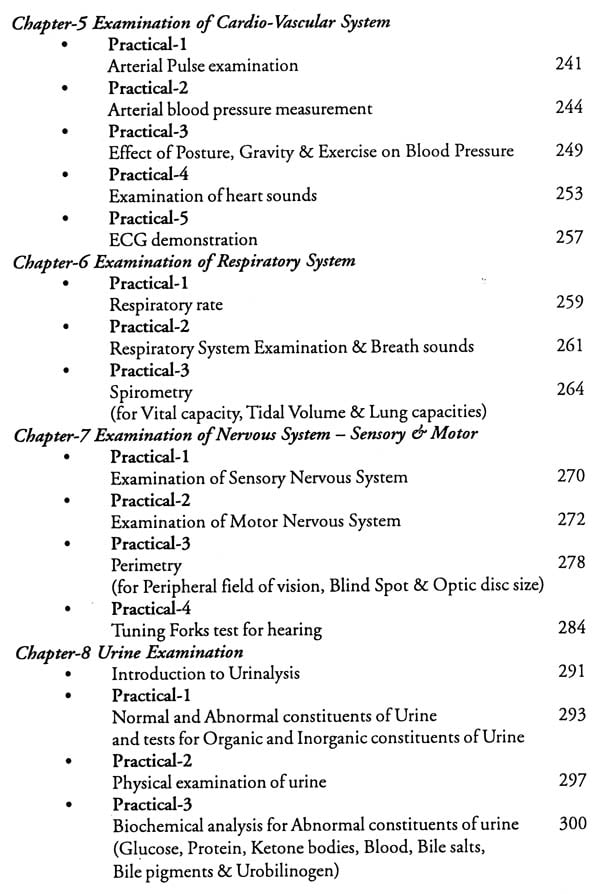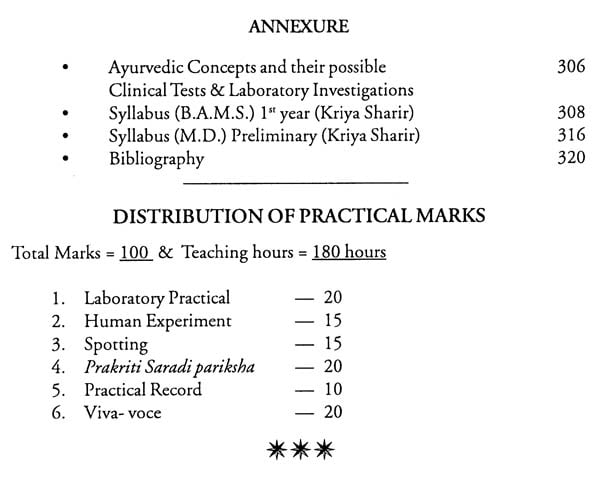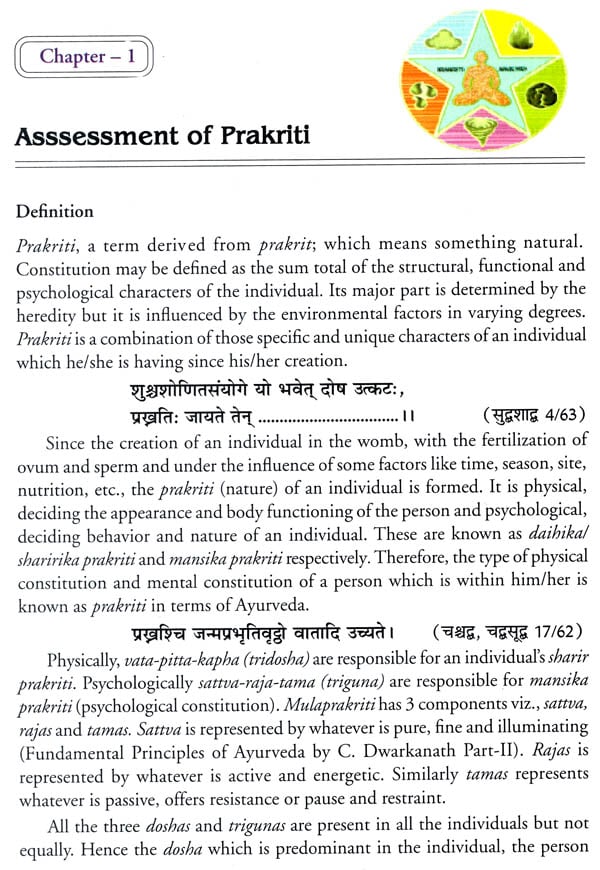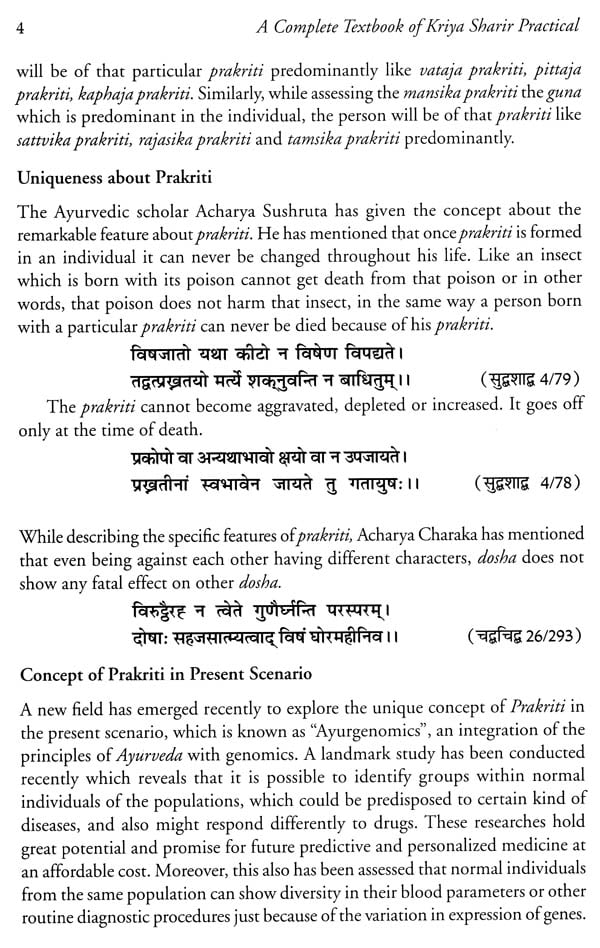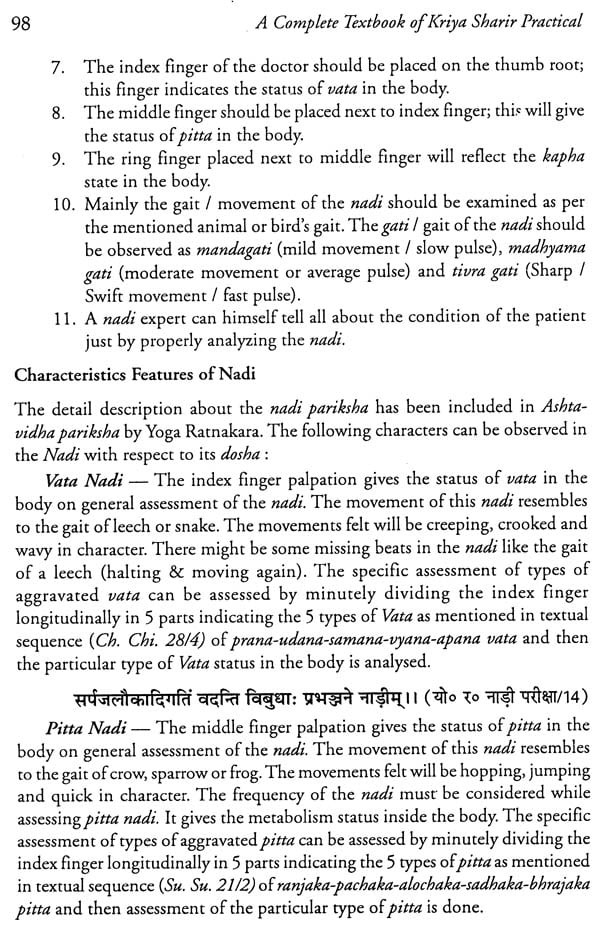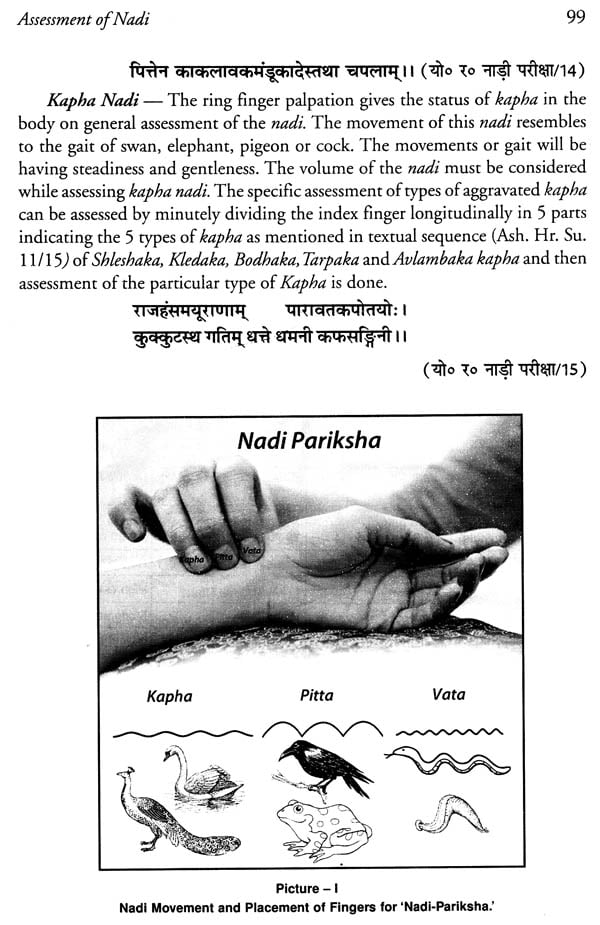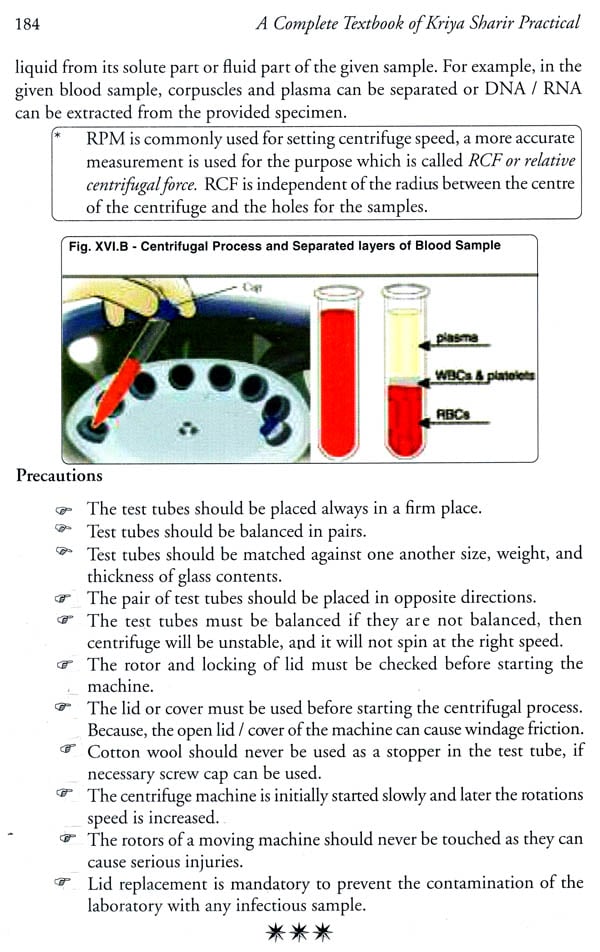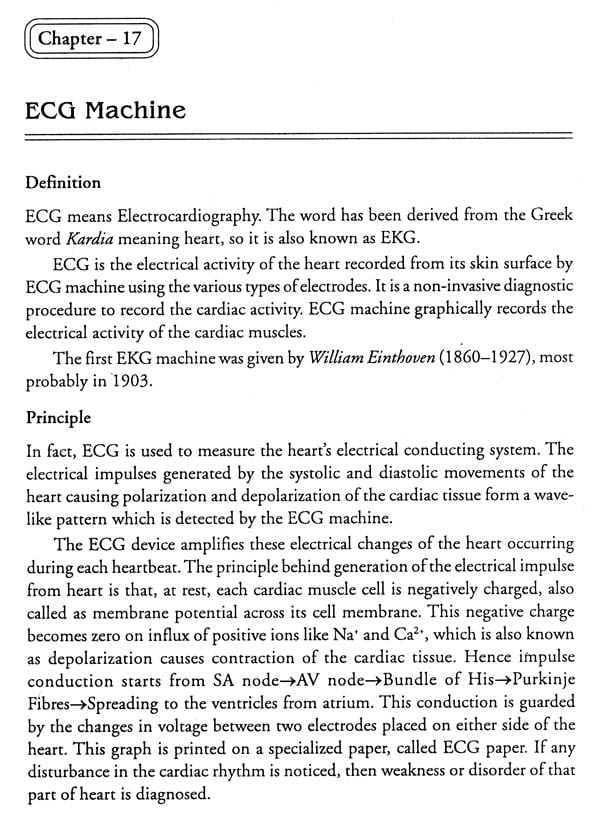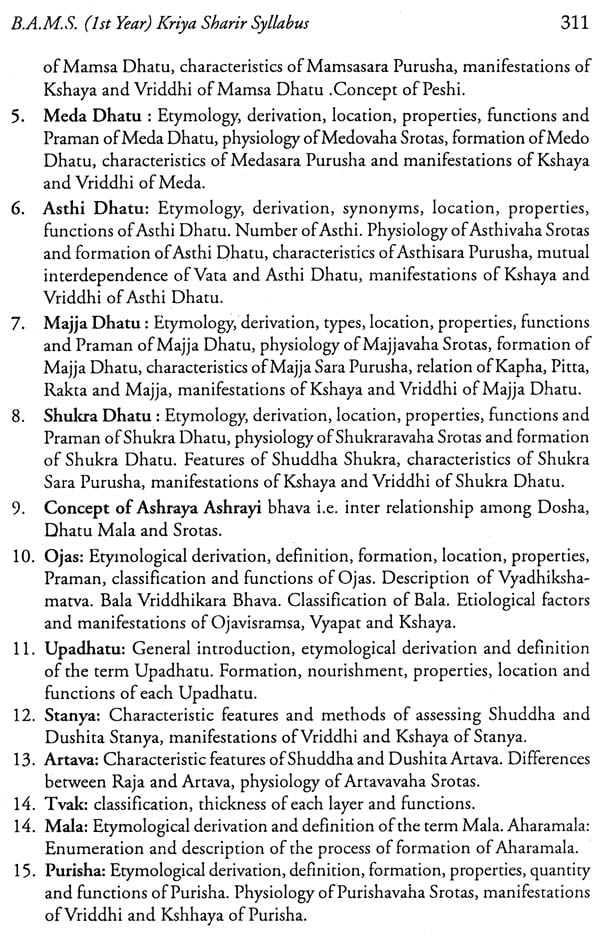
A Complete textbook of Kriya Sharir Practical (As per CCIM Syllabus for UG & PG)
Book Specification
| Item Code: | NAV415 |
| Author: | Smita Arora |
| Publisher: | Chaukhamba Sanskrit Pratishthan |
| Language: | English |
| Edition: | 2016 |
| ISBN: | 9788170847076 |
| Pages: | 320 (Throughout B/W and 30 Colored Illustrations) |
| Cover: | PAPERBACK |
| Other Details | 10.00 X 6.00 inch |
| Weight | 390 gm |
Book Description
This book aims towards all the students and scholars of Ayurveda who has interest in this ancient Indian system of medicine and want to make the understanding of the unique concepts of Ayurveda Kriya Sharir from scientific point of view.
Highlights
- Chapters in sequence as mentioned in CCIM approved syllabus of B.A.M.S. (1st year) and M.D. (Kriya Sharir) along with distribution OM AAI Ihc Ole ROL Kriya Sharir syllabus.
- Threesections viz. SECTION-I (Kriya Sharir Practical) with Sanskrit verses, SECTION-II (Practical Instruments) & SECTION-III (Modern Physiology Practical).
- All the section contains the observations in tabular form with diagrams & figures.
- The content has Assessment criteria, Assessment Proforma and Practical writing steps like Aim, Material required, Theory, Principle, Uniqueness of concept, Clinical Significance, Method / Procedure, Observation Tables, Relevant Figures, Result format etc. along with Questionnaire at the end of Topic.
- This book will set a new horizon for the authenticated scientific research in the field of Kriya Sharir and Ayurveda.
- Avery useful book for undergraduate and postgraduate students of Ayurveda.
- A complete Practical book of Kriya Sharir with classical verses & latest researches.
Dr. Smita Arora has been a renowned Ayurvedic scholar all through her journey of being in Ayurveda profession. She completed’ her graduation (B.A.M.S.) and postgraduation (M.D. in Kriya Sharir) from A. & U. Tibbia College, New Delhi (University of Delhi) and pursued her PhD in Ayurveda from Dr. Sarvepalli Radhakrishnan Rajasthan Ayurved University, Jodhpur in 2013. She has been a meritorious scholar throughout her academic career. She has done Health Management course from NIHFW, New Delhi (Govt. of India). Presently she is working as Assistant Professor in Department of Kriya Sharir in Ch. Brahm Prakash Ayurved Charak Sansthan, New Delhi (Govt. of NCT Delhi) since 2010. She has served for 3 years as Lecturer in Shri Baba Mast Nath Ayurvedic College, Asthal Bohar, Rohtak, Haryana. She has worked with CSIR and CCRAS in research project as ‘Ayurveda Expert’. She has got more than 8 years of teaching experience in Kriya Sharir (Physiology) and 2 years of Research experience in the field of Ayurveda. She also has been a certified AIDS (control & prevention) trainer for CCRH. She has presented (in seminars) and published several scientific research papers and articles in peer review journals. She is popular amongst the students of being a teacher with great ideas and simple explanations of the concepts with common examples. This book seems to be the essence of her teaching & research excerience in the field of Ayurveda and the book has been authored in a very sinrolified and scientific manner to explore the practical aspects of Kriya Sharir.
I have the honour to go through the book entitled "A COMPLETE TEXTBOOK OF KRIYA SHARIR PRACTICAL (AYURVEDIC PRACTICAL PHYSIOLOGY)" authored by Dr. Smita Arora, M.D. (Kriya Sharir), Ph.D., who is working as Assistant Professor in Deptt of Kriya Sharir in Ch. Brahm Prakash Ayurved Charak Sansthan, New Delhi (Govt. OF NCT Delhi). The book is presented by the competent author under three sections viz. Section-I (Kriya Sharir Practical) with Sanskrit verses, Section-II (Practical Instruments) & Section-HI (Modern Physiology Practical).
For an Ayurvedic scholar it is very important to go through detailed human anatomy and physiology for proper understanding of various approaches used for treating various patients of different diseases. Many a times it is apparent to confirm Ayurvedic diagnosis with the help of various diagnostic and investigative cools and technology as available today. Different confirmatory tests are being performed in highly sophisticated laboratories. To provide glimpses of various laboratory investigations in the form of laboratory practicals to the students and teachers of Ayurveda is a great contribution of the author. In the first section the author has given very precise and scientific information regarding assessment of Prakriti, Dosha, Dhatu, Agni, Koshta, Sara, Nadi, Pramana, Mutra Pariksha, Mala Pariksha etc. with adequate Sanskrit verses, original references and scientific explanations at relevant places, which adds to the beauty of the book.
Section-II is dealt with various Practical Instruments being used for practical pourposes. Various diagrams and latest information about the instruments have added quality to the work. Some important questionnaire given towards the end of chapters adds to the analytic and critical knowledge of the reader over the subject
Several modern physiology practicals are described in section-III with detailed Methodology and beautiful diagrams. Various illustrative slides and tables at relvant places make the content material very rich. Examination of various systems has been described with great accuracy and scientific temperament. Overall the presentation of the book is very impressive. All related information about Practicals of Kriya Sharir including Modern Physiology are provided at one place which enables the prospective reader to get the desired information at one place. Very few books are available on the subject. I congratulate the author for bringing out very useful and complete book for UG, PG Scholars and teachers on the subject. Dr. Smita Arora is a pushing, hard working, intelligent scholar with an illustrious career. I wish her great success in her maiden venture of bringing out such a useful book for Ayurvedic fraternity.
At this very juncture of completion of this book, I thank "Maa Jagdambey’, the Aadi Shakti, for blessing me and giving me the enough strength and intellect to accomplish this task smoothly.
While starting this book, the very first thought which came into my mind was the proverb of a Hungarian Biochemist Albert Szent-Gyorgyi, who said "Research is to see what everybody else has seen and to think what nobody else has thought". 1 would call my this task a research rather than a simple textbook, since many concepts which we usually study, discuss and attempt in the exams though seem to be just a part of syllabus yet actually they exhibit the depth of Ayurveda and its unique concepts. In present book such an attempt has been taken to justify the concepts of Ayurvediya Kriya Sharir from practical point of view.
All the Ayurvedic scholars and students are very much familiar with the basic concepts of dosha-dhatu-mala framing the basic physiology, i.e. Sharir Kriya, but very few of them accept these in a scientific way. Ayurveda is not just a study of ‘Read-Learn & Write’ nowadays, rather the present era of research has set the goal for each and every concept whichever has been written in the epics or classical Ayurvedic textbooks. This book aims towards all the students and scholars of Ayurveda who have interest in this ancient Indian system of medicine and want to make the understanding of the unique concepts of Ayurvediya Kriya Sharir from scientific and authentic point of view.
Highlights of the Book
- The book follows the new syllabus of B.A.M.S. (1 year) and M.D. (Kriya Sharir) and the chapters have been presented in sequence as mentioned in CCIM approved syllabus.
- For convenience of the students and scholars, the book has been divided into three sections, viz. Section — I (Kriya Sharir Practical) which contains the practical analysis of the Ayurvedic concepts of Kriya Sharir only and the Classical Verses have been given in Sanskrit; Section-II (Practical Instruments), this section provides all the necessary information about the instruments / equipments mentioned in the syllabus and usually come into use in performing the Physiology practicals and Section - III (Modern Physiology Practical), in this section the modern physiology practical has been included.
- Anew direction has been given to the Ayurvedic Kriya Sharir Practical by implementation of Ayurvedic Classical text methods from modern diagnostic point of view.
- All the contents of the book have been given in the form of Aim, Material required, Theory, Principle, Uniqueness of concept, Clinical Significance, Method / Procedure, Observation Tables, Relevant Figures, Result format, etc. to make the text convenient and easy to understand.
- The relevant Questionnaire from the concerned chapter has been given at the end of the chapter.
- As far as possible the commonly used simple English has been used in this book so that the inductive students of Ayurveda (1 year budding Ayurvedic Physicians) can understand the concept of Ayurveda easily.
- For PG scholars who are pursuing M.D./M.S. in Ayurveda, this book will provide a new horizon for the authenticated scientific research. I hope this book will be proved helpful for undergraduate and postgraduate students of Ayurveda.
Lastly, with my humble regards and sincere thanks to my parents, life-partner, kids and to all my teachers and ‘Guru’ whose love and blessings helped me to reach at this destination. I must offer my most profound gratitude to my Guru Prof. (Dr.) Ajay Kumar Sharma for appreciating my hard work and encouraging me with his blessed words by writing Foreword note for this book. I would like to say that "We are called to be faithful, to take those first difficult steps and to leave the results up to God".
